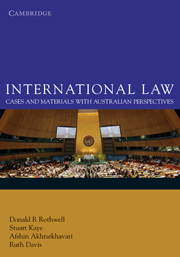Book contents
- Frontmatter
- Contents
- Preface
- About the authors
- Acknowledgements
- Table of cases
- Table of statutes
- Table of treaties and other international instruments
- Abbreviations
- 1 The nature of international law
- 2 Sources of international law
- 3 Law of treaties
- 4 International and municipal law
- 5 International legal personality
- 6 Sovereignty over territory
- 7 Jurisdiction
- 8 State responsibility
- 9 Human rights
- 10 Law of the sea
- 11 International environmental law
- 12 Enforcement of international law
- 13 The peaceful settlement of international disputes
- Index
- References
11 - International environmental law
- Frontmatter
- Contents
- Preface
- About the authors
- Acknowledgements
- Table of cases
- Table of statutes
- Table of treaties and other international instruments
- Abbreviations
- 1 The nature of international law
- 2 Sources of international law
- 3 Law of treaties
- 4 International and municipal law
- 5 International legal personality
- 6 Sovereignty over territory
- 7 Jurisdiction
- 8 State responsibility
- 9 Human rights
- 10 Law of the sea
- 11 International environmental law
- 12 Enforcement of international law
- 13 The peaceful settlement of international disputes
- Index
- References
Summary
Introduction: Trends in international law-making for the environment
International environmental law provides a useful example of a rapidly developing field of international law, and demonstrates some of the difficulties involved in resolving modern global problems within the traditional legal framework.
International environmental law is a relatively recent development. The environment did not feature in the Charter of the United Nations (UN Charter) and none of the UN's constituent bodies was expressly given an environmental mandate. Since the 1960s, however, we can trace a steady growth in international law concerned with environmental problems. This growth of law at the international level is mirrored by Australia's domestic environmental law experience. Both reflect the growing public awareness of environmental issues and the demand for a legal response.
Various trends in the development of international environmental law may be recognised. Historically, this area of law developed as a reaction to particular instances of harm, resulting in agreements that deal with a single issue: for example, prevention of one type of pollution or protection of a particular species of wildlife. More recently, problems that are truly global have become apparent – depletion of the ozone layer, global warming and the loss of biological diversity, for example. International agreements have increased in scope in response to these developments. They have also attempted to become more forward-thinking instead of simply reacting to a problem that has already occurred.
- Type
- Chapter
- Information
- International LawCases and Materials with Australian Perspectives, pp. 556 - 603Publisher: Cambridge University PressPrint publication year: 2010

